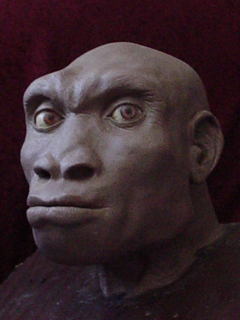The Fine Art of Facial Reconstruction
A step by step on how forensic facial reconstructions are made
|
|
|
The Face of the Nariokotome Boy
by Brian
Pierson
Since their respective
reconstructions, there have been very few published articles on “Kennewick
Man,” “Lucy,” or the “Ice Man,” that have not included photographs of
these reconstructions. Clearly, early hominid facial reconstruction
is important to our overall understanding of these creatures and for our
ability to relay their appearance to the public. Anthropologists,
laypeople and students benefit from visual aids; by accurately
reconstructing early hominids by using modern techniques, they are able to
appreciate what the hominids looked like in life, much more than by
looking at a fossilized skull.
The finished face of the “Nariokotome boy” can be used as a teaching aid with which to compare future findings. The finished reconstruction will permit scientists and laypersons from fields outside Paleoanthropology to study the morphology of H. ergaster and perhaps (as has been shown in the past) add to our knowledge of these early hominids.
|
|
|
The reconstruction process begins with a casting which was made from the fossilized remains of KNM-WT-15000 (the designation of the Nariokotome Boy). The next step is to rebuild the damage of 1.6 million years of neglect. The skull is resculpted; voids are filled and the missing nasal bones, Zygomatics, and Super orbital torus, are rebuilt. The eyes are created and put into place. Then, using modeling clay, the soft tissue is laid on.
There are two basic methods of reconstruction
developed for use in Forensic Science. The first could be called the
"American Method" which uses known facial depths on certain points of the
skull, they then fill in the voids with a sort if latticework of clay to
approximate the face. The second method can be termed "the Gerasimov
Method" that builds up the musculature of the face and then places a skin
over that to approximate the face (The Gerasimov method was developed by
the late Russian paleontologist Mikhail Gerasimov). Both schools
produce similar basic results. For this reconstruction, I decided to use
an amalgam of both methods: I used tissue depth thicknesses recently
gathered of modern W. Africans, placed tissue depth markers, and then
built up the musculature according to the Gerasimov method.
|
|
|
With the markers in place, I centered the eyes in the sockets and roughed out the size of the nose and mouth. Forensic science has developed many methods to determine the profile of the nose. One approach, used primarily by the American school, estimates the projection of the nose at three times the length of a bony spur located beneath the nasal opening in the skull. The width of the nostril wings is a set distance from the lateral edges of the nasal openings, six millimeters for Europeans and Asians and eight millimeters for Africans. The Gerasimov school creates the outline of the nose by extending one line from the bridge of the nose and a second line from the floor of the nasal opening, and then rounding their point of intersection to make the tip of the nose. They estimate nose width as 1.67 times the width of the nasal opening. The width of the mouth is either the distance between the inner edges of the irises in the eyes or the distance between the lateral edges of the canine teeth, all of these measurements typically have the same result.
|
|
|
As the project has progressed, it has yielded many surprises. For example, the skin depth thicknesses were well documented, but the best we can do is an estimation based on modern day examples. This leaves the nagging specter of uncertainty. I was a little apprehensive that they may not work. For instance, the flesh thicknesses around the mouth looked as if they were going to be much too thick (I thought they were going to obscure the nostrils). To my amazement all of the flesh thicknesses worked out perfectly. The skin is made of silicone, the eyes are made of resin (see link below). Please tell me what you think about this project, ask me questions about the project, or to order a casting.

The Finished Sculpture
Check Out Our Other Projects!








 The
face of the Nariokotome Boy, as reconstructed by Brian
Pierson
The
face of the Nariokotome Boy, as reconstructed by Brian
Pierson
 A model of
the Nariokatome skull (left) and the reconstructed model with the
eyes and nose cartilage in place (right).
A model of
the Nariokatome skull (left) and the reconstructed model with the
eyes and nose cartilage in place (right). The skull
with depth markers in place and the mouth muscles beginning to take
shape.
The skull
with depth markers in place and the mouth muscles beginning to take
shape. The complete
muscle structure.
The complete
muscle structure.